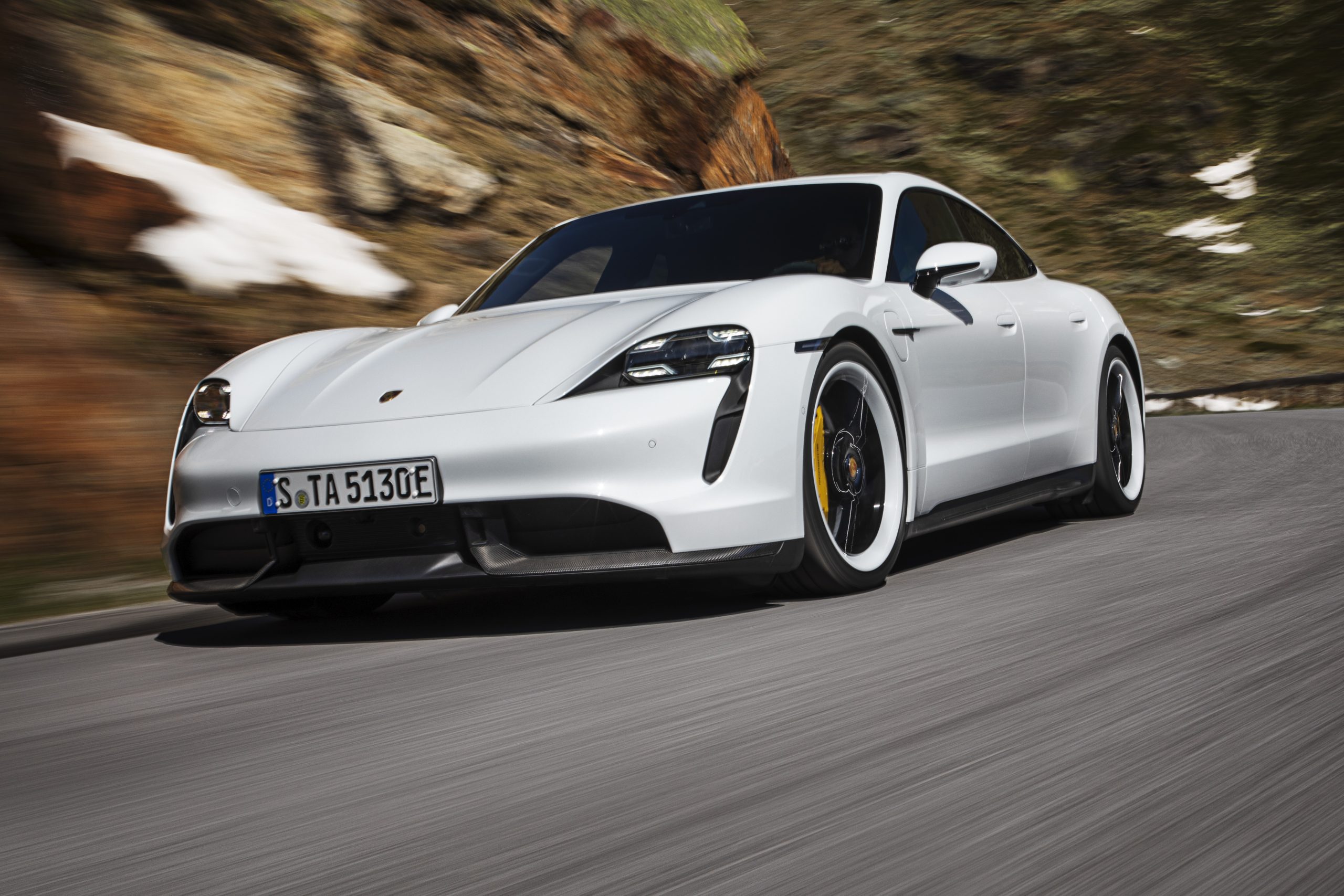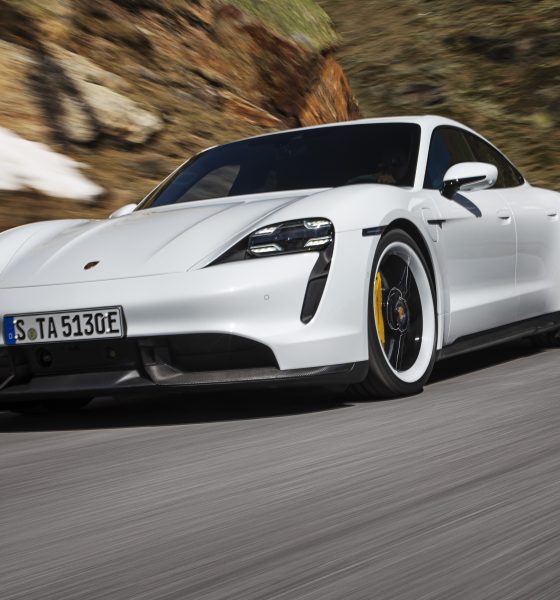

News
Porsche Taycan’s repeatable performance claims put to the test by veteran drag racer
When Porsche launched the Taycan last year, its message was clear. It’s an all-electric performance car built for the track. You can take it with a battery half charged and you’ll still get the same level of performance you’d expect at full charge. At least that’s what Porsche promises.
DragTimes YouTube channel host and Tesla owner Brooks Weisblat recently put the Taycan Turbo’s repeatable performance claim to a real-world test. He took a Taycan Turbo and the more powerful Turbo S out on the track to see how they would perform launching from 0 to 60 mph and covering the 1/4 mile.
Weisblat specifically asked the engineers at Champion Porsche in Pompano Beach, FL to have both cars ready at full charge. However, while the Turbo had a 91% charge when he arrived, while the Turbo S was only at 57%. This presented a unique opportunity to test just how well the vehicles performed with such discrepancy in their battery levels.
At just a little bit more than half charge, the $185,000 Turbo S went from 0 to 60 mph in 2.67 seconds and ran a quarter-mile at 124 mph. It’s impressive for an all-electric vehicle but not so much for one housing the world’s first two-speed gearbox in an electric car.
“I kind of expected it to be a little better especially given it having the transmission,” Weisblat says. “I was expecting track speeds near 130 mph. The launch I wasn’t so sure because Porsche’s claiming it does 0 to 60 in 2.8 seconds.”
Previous testing done by DragTimes shows the Tesla Model S with a 96 percent charge can go from 0 to 60 mph in 2.45 seconds. That’s a couple of tenths of a second faster than the Turbo S, which has acceleration and speed advantages due to its two-speed transmission.
The Turbo, which has 90 less horsepower than the Turbo S, went from 0 to 60 mph at 2.8 seconds. It’s not as fast as the Turbo S but it’s nothing to scoff at. But here’s the kicker. After the first 60 mph, the Turbo S didn’t have much of an advantage over the less powerful Turbo. If the state of charge doesn’t matter as Porsche says, the Turbo should have at least similar or less performance.
But Weisblat’s testing shows the Turbo at 91% charge went from 60 to 100 mph in 8.41 seconds and took the 1/4 mile at 127 mph. That’s a whole 3 mph faster than the Turbo S, which was at 56% charge when testing began. Had both cars been raced against each other, the Turbo would have won hands down over the Turbo S. Weisblat also says that both Turbo and Turbo S used up about 2% of the battery after each 1/4 mile.
“State of charge does matter with the Porsche. There’s no question about it. Because the Taycan Turbo S sitting at 56 percent is tracking at 124 mph. The Turbo at 91 percent is going 3 mph faster. For those of you who don’t know about road racing or drag racing, that is a significant difference,” he said.
The results would have been different had both cars been charged fully. Weisblat estimates the Turbo S could go the 1/4 mile at 130 mph and launch from 0 to 60 mph at around 2.5 seconds so that it’s right in line with the Tesla Model S. However, he believes that the Turbo S would further drop to 7 seconds once it goes from 60 to 130 mph, just up to par with a Lamborghini Huracan. If so, he says the Model S could be “in trouble,” at least when you take it down to the race track.
To maintain these numbers, Porsche has to keep the Taycan’s battery at optimal temperatures using a unique battery thermal management system. Unfortunately, because the car relies purely on electricity, the Taycan uses up extra energy from the battery just to maintain its energy-intensive temperature control system.
It’s a double-edged sword, especially for an electric vehicle. Porsche had to sacrifice a few things in exchange for performance. A lot of people weren’t happy to hear that the EPA gave the Taycan Turbo S a range rating of 192 miles. The Taycan Turbo didn’t do much better at 201 miles, which is 182 whole miles less than the 373 miles of the Model S Long Range.
But then again, the Taycan isn’t exactly made for most people. In fact, with a six-figure price tag and the Porsche logo on its hood, it’s not even made for mainstream EV buyers. And it’s a good thing for the electric car market as a whole.

News
Tesla FSD fleet is nearing 7 billion total miles, including 2.5 billion city miles
As can be seen on Tesla’s official FSD webpage, vehicles equipped with the system have now navigated over 6.99 billion miles.

Tesla’s Full Self-Driving (Supervised) fleet is closing in on almost 7 billion total miles driven, as per data posted by the company on its official FSD webpage.
These figures hint at the massive scale of data fueling Tesla’s rapid FSD improvements, which have been quite notable as of late.
FSD mileage milestones
As can be seen on Tesla’s official FSD webpage, vehicles equipped with the system have now navigated over 6.99 billion miles. Tesla owner and avid FSD tester Whole Mars Catalog also shared a screenshot indicating that from the nearly 7 billion miles traveled by the FSD fleet, more than 2.5 billion miles were driven inside cities.
City miles are particularly valuable for complex urban scenarios like unprotected turns, pedestrian interactions, and traffic lights. This is also the difference-maker for FSD, as only complex solutions, such as Waymo’s self-driving taxis, operate similarly on inner-city streets. And even then, incidents such as the San Francisco blackouts have proven challenging for sensor-rich vehicles like Waymos.
Tesla’s data edge
Tesla has a number of advantages in the autonomous vehicle sector, one of which is the size of its fleet and the number of vehicles training FSD on real-world roads. Tesla’s nearly 7 billion FSD miles then allow the company to roll out updates that make its vehicles behave like they are being driven by experienced drivers, even if they are operating on their own.
So notable are Tesla’s improvements to FSD that NVIDIA Director of Robotics Jim Fan, after experiencing FSD v14, noted that the system is the first AI that passes what he described as a “Physical Turing Test.”
“Despite knowing exactly how robot learning works, I still find it magical watching the steering wheel turn by itself. First it feels surreal, next it becomes routine. Then, like the smartphone, taking it away actively hurts. This is how humanity gets rewired and glued to god-like technologies,” Fan wrote in a post on X.
News
Tesla starts showing how FSD will change lives in Europe
Local officials tested the system on narrow country roads and were impressed by FSD’s smooth, human-like driving, with some calling the service a game-changer for everyday life in areas that are far from urban centers.

Tesla has launched Europe’s first public shuttle service using Full Self-Driving (Supervised) in the rural Eifelkreis Bitburg-Prüm region of Germany, demonstrating how the technology can restore independence and mobility for people who struggle with limited transport options.
Local officials tested the system on narrow country roads and were impressed by FSD’s smooth, human-like driving, with some calling the service a game-changer for everyday life in areas that are far from urban centers.
Officials see real impact on rural residents
Arzfeld Mayor Johannes Kuhl and District Administrator Andreas Kruppert personally tested the Tesla shuttle service. This allowed them to see just how well FSD navigated winding lanes and rural roads confidently. Kruppert said, “Autonomous driving sounds like science fiction to many, but we simply see here that it works totally well in rural regions too.” Kuhl, for his part, also noted that FSD “feels like a very experienced driver.”
The pilot complements the area’s “Citizen Bus” program, which provides on-demand rides for elderly residents who can no longer drive themselves. Tesla Europe shared a video of a demonstration of the service, highlighting how FSD gives people their freedom back, even in places where public transport is not as prevalent.
What the Ministry for Economic Affairs and Transport says
Rhineland-Palatinate’s Minister Daniela Schmitt supported the project, praising the collaboration that made this “first of its kind in Europe” possible. As per the ministry, the rural rollout for the service shows FSD’s potential beyond major cities, and it delivers tangible benefits like grocery runs, doctor visits, and social connections for isolated residents.
“Reliable and flexible mobility is especially vital in rural areas. With the launch of a shuttle service using self-driving vehicles (FSD supervised) by Tesla in the Eifelkreis Bitburg-Prüm, an innovative pilot project is now getting underway that complements local community bus services. It is the first project of its kind in Europe.
“The result is a real gain for rural mobility: greater accessibility, more flexibility and tangible benefits for everyday life. A strong signal for innovation, cooperation and future-oriented mobility beyond urban centers,” the ministry wrote in a LinkedIn post.
News
Tesla China quietly posts Robotaxi-related job listing
Tesla China is currently seeking a Low Voltage Electrical Engineer to work on circuit board design for the company’s autonomous vehicles.

Tesla has posted a new job listing in Shanghai explicitly tied to its Robotaxi program, fueling speculation that the company is preparing to launch its dedicated autonomous ride-hailing service in China.
As noted in the listing, Tesla China is currently seeking a Low Voltage Electrical Engineer to work on circuit board design for the company’s autonomous vehicles.
Robotaxi-specific role
The listing, which was shared on social media platform X by industry watcher @tslaming, suggested that Tesla China is looking to fill the role urgently. The job listing itself specifically mentions that the person hired for the role will be working on the Low Voltage Hardware team, which would design the circuit boards that would serve as the nervous system of the Robotaxi.
Key tasks for the role, as indicated in the job listing, include collaboration with PCB layout, firmware, mechanical, program management, and validation teams, among other responsibilities. The role is based in Shanghai.
China Robotaxi launch
China represents a massive potential market for robotaxis, with its dense urban centers and supportive policies in select cities. Tesla has limited permission to roll out FSD in the country, though despite this, its vehicles have been hailed as among the best in the market when it comes to autonomous features. So far, at least, it appears that China supports Tesla’s FSD and Robotaxi rollout.
This was hinted at in November, when Tesla brought the Cybercab to the 8th China International Import Expo (CIIE) in Shanghai, marking the first time that the autonomous two-seater was brought to the Asia-Pacific region. The vehicle, despite not having a release date in China, received a significant amount of interest among the event’s attendees.








